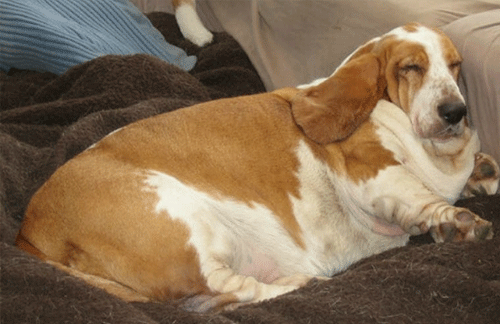
Just like many people in the developed world, the rate of obesity in their dogs is also climbing. According to the Association for Pet Obesity Prevention (APOP), they estimate that about 45% of dogs in the USA are overweight and that the rate is climbing by about 2% each year. Although these figures are for the USA, the results for most other developed countries including Australia would be expected to be similar. Regardless of the actual figures, the general trend of dogs becoming overweight is being seen by many veterinarians.
Just like in their human owners, being overweight will add many stresses to their body and joints in particular especially during the growth phase of their life. Dogs with extra weight will also have an increased risk of diabetes, liver problems and cardiovascular issues.
Many dog owners do not recognise the signs of an overweight dog until they would be classified as obese. A general rule of thumb is to feel around your dog’s ribs and spine. You should be able to feel the ribs and spine and a thin layer of fat between the skin and these bones. If you cannot feel the ribs through the skin without pressing, then you may have an overweight dog on your hands! You should also notice a waist between the ribcage and the hips of your dog where the tummy tucks in.
Dogs of particular breeds do seem to have a propensity to become overweight and it is believed to be a result of both genetics and lifestyle which is similar to the weight of most people. Some of the traditional breeds that are in this catergory are Labradors, Golden Retrievers, Beagles, Pugs, Dachshunds and Cavalier King Charles Spaniels. Designer breeds such as Labradoodles, Groodles, Puggles, Beagliers and Pugaliers are also known to pile on the extra weight a little easier than other designer breeds such as Cavoodles, Spoodles, Moodles or Poochons.
Dogs only eat what we allow them to eat, so if your dog is on the heavy side it is probably due to what and how much you are feeding her. Try to stick to their regular diet and reduce the number of treats they are given. If you are using treats as rewards for training, try to move to praise as a reward or reduce the amount of regular food feed that evening if they have received quite a few treats that day. Avoid feeding your dog people food (especially snacks and fried food) that are high in fats and/or sugar.
Always remember to consult your veterinarian before and during reducing your dog’s weight and write down your dog’s weight on a regular basis to track their progress.
Victorian Minister Approved Kennels
Over 30 years experience
Domestic Animal Business Permit No: 121/2020/13876
Melton City Council
Source Number: BR109724